

Today's culture is biased towards business. I discuss culture without paying any attention to what sells. I am interested in great artists, musicians, writers, etc, regardless of how the business and the establishment perceives them. I also try to apply a historical perspective: history is my main interest.
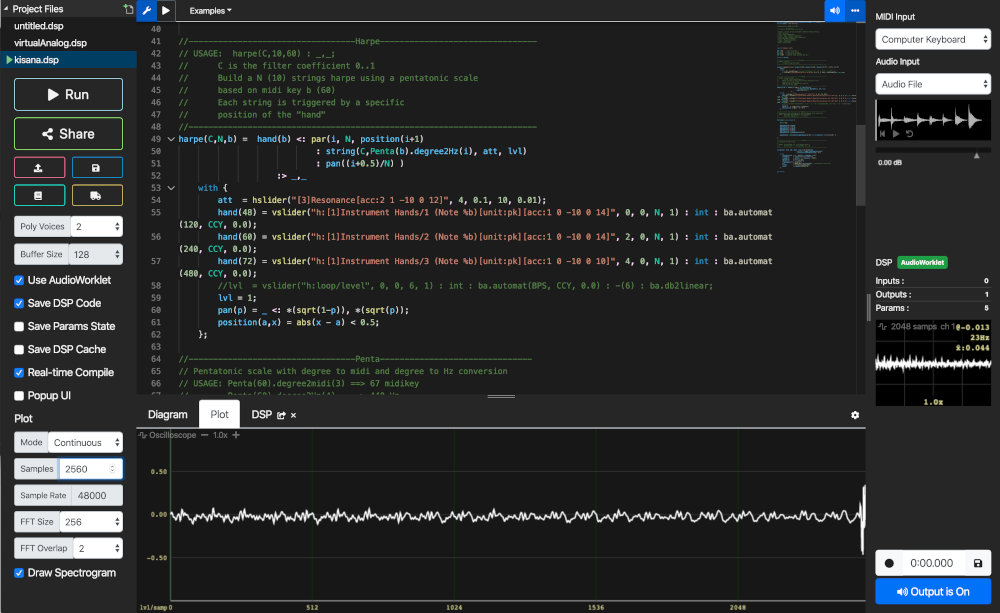
https://github.com/grame-cncm/faust
Faust (Functional Audio Stream) is a functional programming language for sound synthesis and audio processing with a strong focus on the design of synthesizers, musical instruments, audio effects, etc. Faust targets high-performance signal processing applications and audio plug-ins for a variety of platforms and standards. It is used on stage for concerts and artistic productions, in education and research, in open source projects as well as in commercial applications.
The core component of Faust is its compiler. It allows us to "translate" any Faust digital signal processing (DSP) specification to a wide range of non-domain specific languages such as C++, C, JAVA, JavaScript, LLVM IR, WebAssembly, etc. In this regard, Faust can be seen as an alternative to C++ but is much simpler and intuitive to learn.
Thanks to a wrapping system called "architectures," codes generated by Faust can be easily compiled into a wide variety of objects ranging from audio plug-ins to standalone applications or smartphone and web apps, etc.

https://law.duke.edu/sites/default/files/centers/cspd/musiccomic/Theft.pdf
This comic lays out 2000 years of musical history. A neglected part of musical history. Again and again there have been attempts to police music; to restrict borrowing and cultural cross-fertilization. But music builds on itself. To those who think that mash-ups and sampling started with YouTube or the DJ’s turntables, it might be shocking to find that musicians have been borrowing—extensively borrowing—from each other since music began. Then why try to stop that process? The reasons varied. Philosophy, religion, politics, race—again and again, race—and law. And because music affects us so deeply, those struggles were passionate ones. They still are.
The history in this book runs from Plato to Blurred Lines and beyond. You will read about the Holy Roman Empire’s attempts to standardize religious music with the first great musical technology (notation) and the inevitable backfire of that attempt. You will read about troubadours and church composers, swapping tunes (and remarkably profane lyrics), changing both religion and music in the process. You will see diatribes against jazz for corrupting musical culture, against rock and roll for breaching the color-line. You will learn about the lawsuits that, surprisingly, shaped rap. You will read the story of some of music’s iconoclasts—from Handel and Beethoven to Robert Johnson, Chuck Berry, Little Richard, Ray Charles, the British Invasion and Public Enemy.
To understand this history fully, one has to roam wider still—into musical technologies from notation to the sample deck, aesthetics, the incentive systems that got musicians paid, and law’s 250 year struggle to assimilate music, without destroying it in the process. Would jazz, soul or rock and roll be legal if they were reinvented today? We are not sure. Which as you will read, is profoundly worrying because today, more than ever, we need the arts.
All of this makes up our story. It is assuredly not the only history of music. But it is definitely a part—a fascinating part—of that history. We hope you like it.
Creates an infinite remix of an audio file by finding musically similar beats and computing a randomized play path through them. The default choices should be suitable for a variety of musical styles. This work is inspired by the Infinite Jukebox (http://www.infinitejuke.com) project creaeted by Paul Lamere
It groups musically similar beats of a song into clusters and then plays a random path through the song that makes musical sense, but not does not repeat. It will do this infinitely.

What is Unmixer?
Unmixer does two things: first, it lets you extract loops from any song; second, it lets you remix these loops in a simple interface.
How do I use it?
Upload a song: drag and drop an audio file (MP3, MP4) into the box with the dotted line
Wait for results: processing a new song can take several minutes.
Remix the loops: turn each sound on and off by clicking the box.
Upload more songs: you can mash-up sounds from as many songs as you like.Extra features:
The BPM indicator in the top right lets you choose the global tempo.
The download button allows you to save a zipfile of all the loops, along with a map of where they occur in the piece.https://github.com/msieg/deep-music-visualizer
https://www.instagram.com/deep_music_visualizer/
https://www.youtube.com/watch?v=L7R-yBZ5QYc

Want to make a deep music video? Wrap your mind around BigGAN. Developed at Google by Brock et al. (2018)¹, BigGAN is a recent chapter in a brief history of generative adversarial networks (GANs). GANs are AI models trained by two competing neural networks: a generator creates new images based on statistical patterns learned from a set of example images, and a discriminator tries to classify the images as real or fake. By training the generator to fool the discriminator, GANs learn to create realistic images.
Audio stream : http://icecast.spc.org:8000/longplayer
Longplayer is a one thousand year long musical composition. It began playing at midnight on the 31st of December 1999, and will continue to play without repetition until the last moment of 2999, at which point it will complete its cycle and begin again. Conceived and composed by Jem Finer, it was originally produced as an Artangel commission, and is now in the care of the Longplayer Trust.
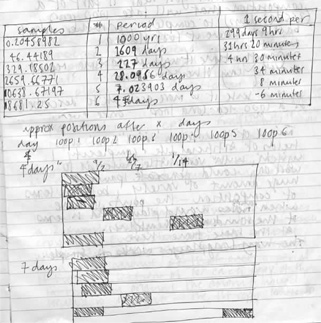
How does Longplayer work?
Early calculations made while trying to establish the correct increments. At the bottom is an estimation of the playing positions on the 7th of January 2000 based on these values.
The composition of Longplayer results from the application of simple and precise rules to six short pieces of music. Six sections from these pieces – one from each – are playing simultaneously at all times. Longplayer chooses and combines these sections in such a way that no combination is repeated until exactly one thousand years has passed. At this point the composition arrives back at the point at which it first started. In effect Longplayer is an infinite piece of music repeating every thousand years – a millennial loop.
The six short pieces of music are transpositions of a 20’20” score for Tibetan Singing Bowls, the ‘source music’.[1] These transpositions vary from the original not only in pitch but also, proportionally, in duration.[2]
Every two minutes a starting point in each of the six pieces is calculated, from which they then play for the next two minutes. Each starting point is calculated by adding a specific length of time to its previous starting point.[3] For each of the six pieces of music this length of time is unique and unvarying. The relationships between these six precisely calculated increments are what gives Longplayer its exact one thousand year long duration.
Rates of Change
In the diagram below, the six simultaneous transpositions are represented by the six circles, whose circumference represents the length of the transposed source music. The solid rectangles represent the two minute sections presently playing. The unique increments by which these six sections advance determine their respective rates of change. These reflect different flows of time, from a glacial crawl to the almost perceptible sweep of an hour hand. The incremental advance of the third circle, is so small that it will take the full thousand years for it to pass once through the source music. Conversely the increment for the second circle is such that it makes its way through the music every 3.7 days. The diagram updates every 2 minutes
https://eclipticalis.com/
http://teropa.info/loop
https://daily.bandcamp.com/lists/generative-music-guide
https://github.com/npisanti/ofxPDSP
Systems music is an idea that explores the following question: What if we could, instead of making music, design systems that generate music for us?
This idea has animated artists and composers for a long time and emerges in new forms whenever new technologies are adopted in music-making.
In the 1960s and 70s there was a particularly fruitful period. People like Steve Reich, Terry Riley, Pauline Oliveros, and Brian Eno designed systems that resulted in many landmark works of minimal and ambient music. They worked with the cutting edge technologies of the time: Magnetic tape recorders, loops, and delays.
Today our technological opportunities for making systems music are broader than ever. Thanks to computers and software, they're virtually endless. But to me, there is one platform that's particularly exciting from this perspective: Web Audio. Here we have a technology that combines audio synthesis and processing capabilities with a general purpose programming language: JavaScript. It is a platform that's available everywhere — or at least we're getting there. If we make a musical system for Web Audio, any computer or smartphone in the world can run it.
With Web Audio we can do something Reich, Riley, Oliveros, and Eno could not do all those decades ago: They could only share some of the output of their systems by recording them. We can share the system itself. Thanks to the unique power of the web platform, all we need to do is send a URL.
In this guide we'll explore some of the history of systems music and the possibilities of making musical systems with Web Audio and JavaScript. We'll pay homage to three seminal systems pieces by examining and attempting to recreate them: "It's Gonna Rain" by Steve Reich, "Discreet Music" by Brian Eno, and "Ambient 1: Music for Airports", also by Brian Eno.
Table of Contents
"Is This for Me?"
How to Read This Guide
The Tools You'll Need
Steve Reich - It's Gonna Rain (1965)
Setting Up itsgonnarain.js
Loading A Sound File
Playing The Sound
Looping The Sound
How Phase Music Works
Setting up The Second Loop
Adding Stereo Panning
Putting It Together: Adding Phase Shifting
Exploring Variations on It's Gonna Rain
Brian Eno - Ambient 1: Music for Airports, 2/1 (1978)
The Notes and Intervals in Music for Airports
Setting up musicforairports.js
Obtaining Samples to Play
Building a Simple Sampler
A System of Loops
Playing Extended Loops
Adding Reverb
Putting It Together: Launching the Loops
Exploring Variations on Music for Airports
Brian Eno - Discreet Music (1975)
Setting up discreetmusic.js
Synthesizing the Sound Inputs
Setting up a Monophonic Synth with a Sawtooth Wave
Filtering the Wave
Tweaking the Amplitude Envelope
Bringing in a Second Oscillator
Emulating Tape Wow with Vibrato
Understanding Timing in Tone.js
Transport Time
Musical Timing
Sequencing the Synth Loops
Adding Echo
Adding Tape Delay with Frippertronics
Controlling Timbre with a Graphic Equalizer
Setting up the Equalizer Filters
Building the Equalizer Control UI
Going Forward

http://tesla1.teslafm.net:8000/tesla1 (copy-paste in VLC)
Schedule : https://tesla1.teslafm.net
A radio on-line just for culturally restless people who looks for non-commercial music, experimentation and counterculture information. From experimental electronic to electroacoustic and sound art; from improvisation to jazz and classical music; from old tunes from 19th century to current compositions; from 80s obscure artefacts to inspired sounds from this decade; cultural archives…, an eclectic journey.
The Silence Secret Society.

Other radios :
Radio tv-syd-dk : http://libretime.tv-syd.dk:8000/stream
Radio Inutile : http://51.254.203.56:8000/mp3_320
Radio Meuh : http://radiomeuh.ice.infomaniak.ch:8000/radiomeuh-128.mp3
Fip Autour du Jazz : http://chai5she.cdn.dvmr.fr/fip-webradio2.mp3
Radio Paradise : http://stream-dc1.radioparadise.com/aac-320
Zen radio : http://zen.radio.mynoise.net/
Nature radio : http://nature.radio.mynoise.net/
Space radio : http://space.radio.mynoise.net/

Le Paradoxe du Temps – Arman, 1961
This guide favors authenticity over accuracy, and it aims to entertain before it informs. It is only as accurate as it feels it needs to be. It is constantly changing and it is infinitely mutable, so the map, the music, and my self-righteous opinions are all subject to change as I discover, investigate, and incorporate new knowledge and more music. Nothing is definitive.
This is an educational resource, not a music sharing service. There are no complete songs here. All tracks are low quality sub-2 minute samples. If you want the music, do the artists a solid and buy it from them through legitimate channels.
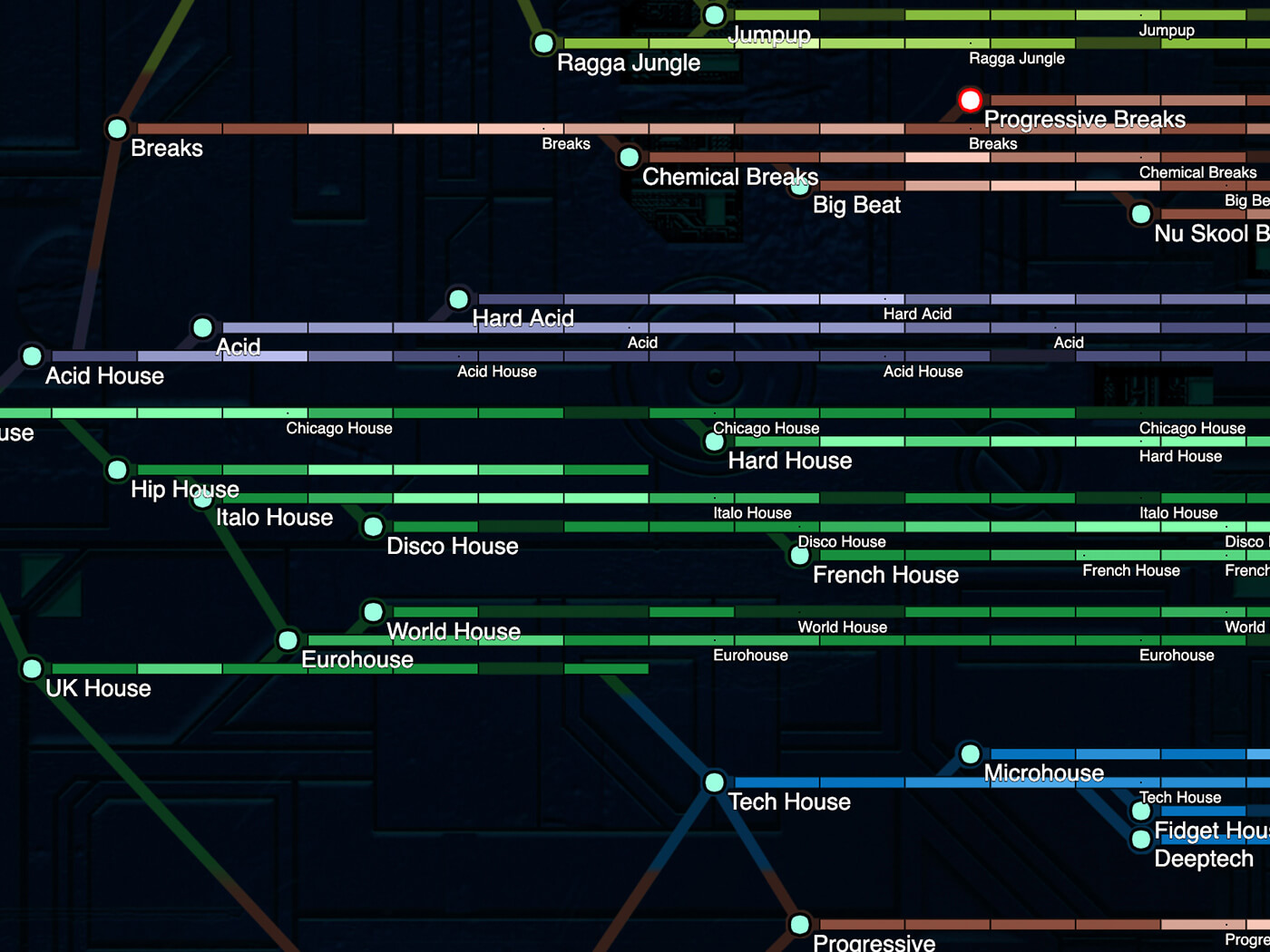
Evoboxx is a synthesizer based on the cellular automaton Game of Life, created by mathematician John Horton Conway in 1970. The game is a zero-player game, meaning that its evolution is determined by its initial state, requiring no further input. One interacts with the Game of Life by creating an initial configuration and observing how it evolves, or, for advanced players, by creating patterns with particular properties.
Beats is a command-line drum machine. Feed it a song notated in YAML, and it will produce a precision-milled Wave file of impeccable timing and feel.

http://beatsdrummachine.com/tutorial/
http://tropone.de/2019/02/21/ungewoehnliche-wege-rhythmen-zu-programmieren-teil-2-beats-cl/
Open-source virtual modular synthesizer

https://vcvrack.com/manual/index.html
https://patchstorage.com/platform/vcv-rack/
https://community.vcvrack.com/
VCV was founded by Andrew Belt in 2016 and is based in Tennessee, USA. Its flagship product VCV Rack was released on September 10, 2017 at Knobcon after two years of development. It was based on an unreleased C++ modular audio engine written by Andrew in 2012.
The Euclidean algorithm (which comes down to us from Euclid’s Elements) computes the greatest common divisor of two given integers. It is shown here that the structure of the Euclidean algorithm may be used to generate, very efficiently , a large family of rhythms used as timelines (ostinatos), in sub-Saharan African music in particular, and world music in general. These rhythms, here dubbed Euclidean rhythms, have the property that their onset patterns are distributed as evenly as possible. Euclidean rhythms also find application in nuclear physics accelerators and in computer science, and are closely related to several families of words and sequences of interest in the study of the combinatorics of words, such as Euclidean strings, to which the Euclidean rhythms are compared.
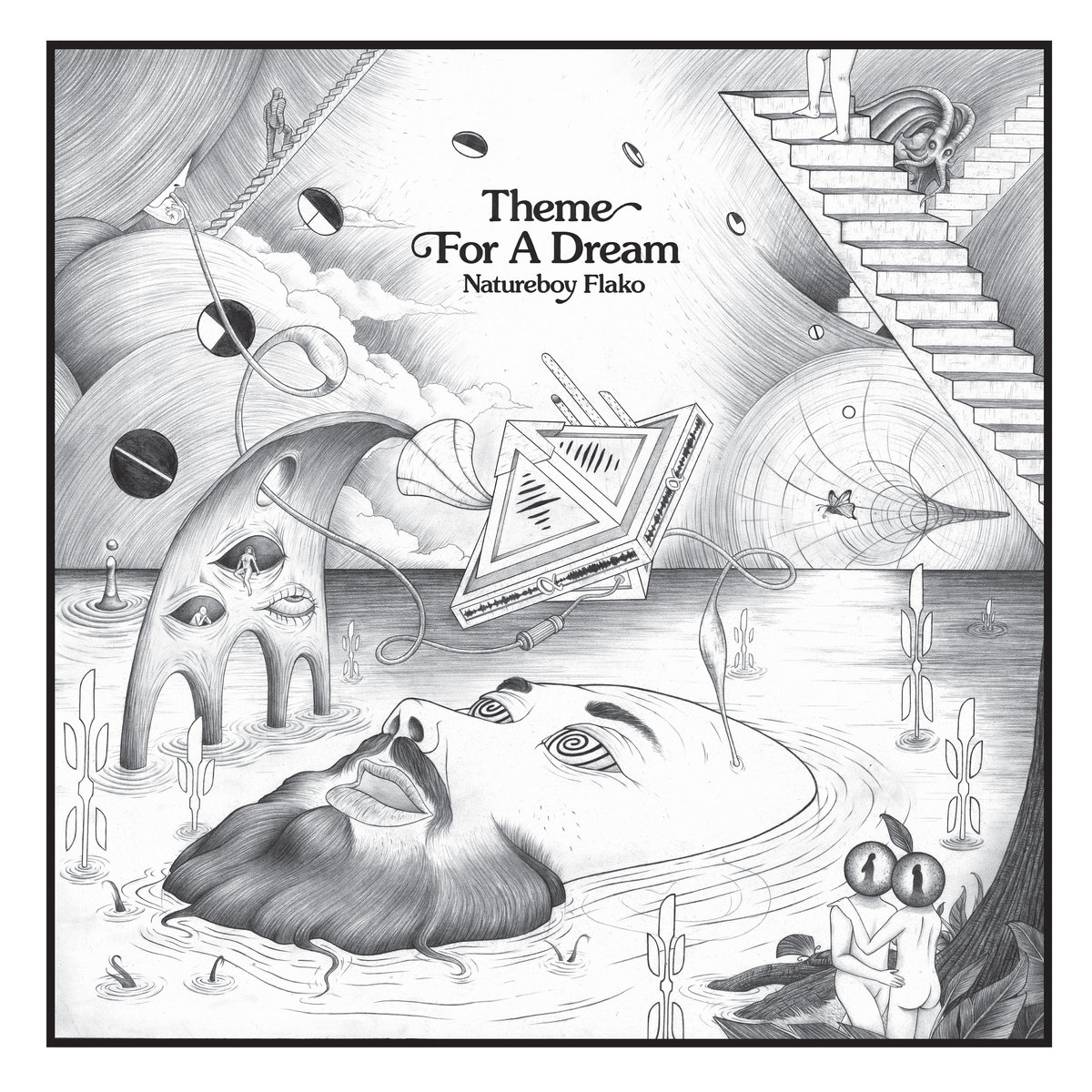
Following a self-titled EP last year, Dario Rojo Guerra aka Natureboy Flako is set to release his second album ‘Theme For A Dream’ on Five Easy Pieces on 20th July 2018. Exploring the boundaries of music, science and spirituality through a prism of colourfully synthesised-sound, heart-pounding rhythm and cinematic soundtracks; the core essence of ‘Theme For A Dream’ is the exploration of the human inner space, the balance of musical energies and music’s healing capabilities.
‘Theme For A Dream’ will be accompanied by an experimental and interactive website that allows users to preview music while being an immersive, unique multi-sensual 4D experience of its own. Snippets of the music from 'Theme For A Dream' become audio visual poetry and an immersive exploration of state of the art technology and oneself.
The “Research” section on this website represents the in-the-making process of the What Music Really İs manual as an interactive presentation, book, and featured documentary. It wishes to be the scientific & mystical knowledge base on the science of music: harmonics, sound, acoustics, tuning and all else related.
“What Music Really İs” is a statement. It is not a question, and not a theory. It is a fact. “What Music Really İs: The Manual for The 3rd Millennium Musician, Spiritual Seeker and Free Energy Discoverer” together with “Harmonic Series Hearing Study for the Liberated Ear”: the only True Ear Training lessons for the development of Perfect Aural Frequency and Harmonic Sonic Distance Recognition are currently the single resources that present music for what it really is, without points of view or centers of interest.
All the concepts presented here are not the result of historical practice, do not adhere to any philosophy, are not linked to any school of taught and do not specifically endorse any form of institutionalized, academic- or esoteric-type of content. The form in which all facts are presented does not make use of any standard (modern or ancient) music theory or nomenclature.
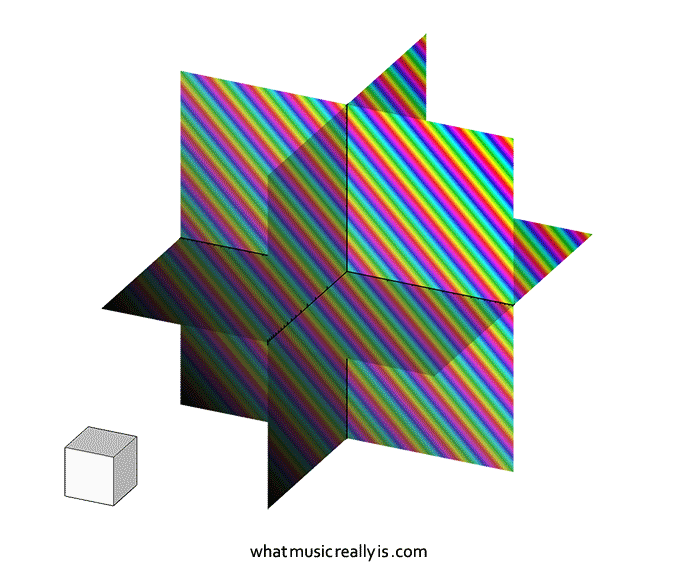
All the bandcamp album made with Pure Data.
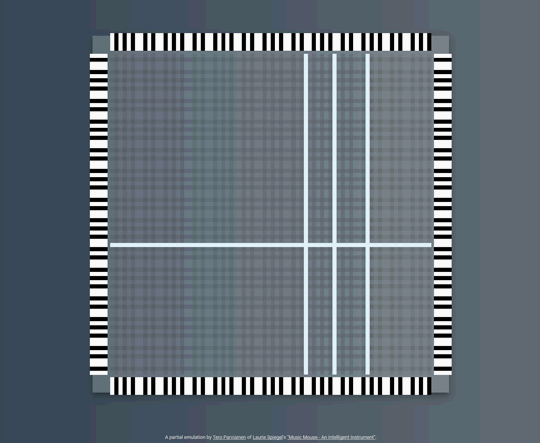
Project put together by Tero Parviainen is a web-based version of musical tool originally by Laurie Spiegel to create music by moving your mouse. It also has MIDI support.
Welcome to SampleRadar, the hub page for MusicRadar's regular giveaway of pro-quality, royalty-free samples. Here you can find links to all of our entries, which feature collections of loops, hits and multisamples in a wide range of genres. And the great news is that you won't have to pay a penny to download any of them.
The samples are supplied as WAV files so can be imported directly into your DAW of choice. Because they're royalty-free, you're welcome to use them in your music in any way you like - all we ask is that you don't re-distribute them.
An oscilloscope can be made to display shapes by playing sounds into it. Making music from these sounds while simultaneously drawing images with those sounds takes things to another level.
In the video I fix up and put an old oscilloscope to a new use, and show how you can watch these audio-visual demos even if you don't have a oscilloscope by using a computer.
If you want to skip the preamble and repair section and jump straight to the demo - it starts at 05:00
Useful Links
Jerobeam Fenderson’s Oscilloscope Music
http://oscilloscopemusic.com
Jerobeam Fenderson’s Youtube Page
https://www.youtube.com/user/jerobeam...
If you have any technical queries - the FAQs here should answer them
http://www.jerobeamfenderson.net/post...
Oscilloscope Emulator for Windows, Mac & Linux
https://asdfg.me/osci/
Reddit Oscilloscope Music Page
https://www.reddit.com/r/oscilloscope...
Here’s a link to a Free Oscilloscope Demo called Youscope
http://makezine.com/2007/08/29/yousco...
If you like seeing oscilloscopes put to unconventional uses - perhaps you'll be interested to see Quake played on one. https://youtu.be/GIdiHh6mW58
You may also be interested to know that the 'first video game' "Tennis for Two" was played on a scope display in 1958
https://en.wikipedia.org/wiki/Tennis_...
If you have an old X/Y capable oscilloscope you'll probably need a pair of BNC male to RCA female converters like these http://amzn.to/2f67Qsk if you want to connect audio devices to it.
My good friend Tony Duggan-Smith built this musical (?) instrument for me, with the intention of using it in horror film score.
It consists of metal rulers which are bowed, a hurdy gurdy like mechanism, a string played with an attached Ebow, a spring reverb (also played with an ebow) some long metal rods, magnets, trash, anything at all to get unnerving sounds.
A credit card sized board, mounted in a wooden box. Musical instrument for your active relaxation, plus open platform for experiments with sound and music making.
https://www.kickstarter.com/projects/967276512/gecho-loopsynth-a-modern-equivalent-of-the-music-b

An Archive of 10,000 Cylinder Recordings Readied for the Spotify Era. The UCSB Library invites you to discover and listen to its online archive of cylinder recordings.

This is an ongoing attempt at an algorithmically-generated, readability-adjusted scatter-plot of the musical genre-space, based on data tracked and analyzed for 1211 genres by The Echo Nest. The calibration is fuzzy, but in general down is more organic, up is more mechanical and electric; left is denser and more atmospheric, right is spikier and bouncier.

MSLP stands for International Music Score Library Project. The logo is a capital letter A, taken from the very first press-printed book of polyphonic music, the Harmonice Musices Odhecaton, published in 1501. Its printer, Ottaviano Petrucci, is this library's namesake.
Tausende Gangnam-Style- und Harlem-Shake-Videos auf Youtube sind der Beleg: Remix ist heute ein Massenphänomen. War das 20. Jahrhundert noch geprägt von zentralisierter Kulturproduktion, laden heute Computer, Videohandys und Internet zu kreativer und öffentlicher Interaktion mit Kulturgütern ein.
Viele der erfolgreichsten Videos auf Youtube und Facebook profitieren davon, dass andere NutzerInnen eigene Versionen von ihnen erstellen und so zur Bekanntheit des Originals beitragen. Die Bandbreite reicht dabei von verwackelten Handy-Videos bis hin zu aufwendigen Remixversionen. Sich für die Erstellung von Werken bei Vorhandenem zu bedienen, ist kein neues Phänomen. Der Blogger Malte Welding illustrierte diesen Umstand einmal unter Verweis auf Wolfgang Amadeus Mozart, der Bach-Fugen bearbeitete und die den Fugen voranstehenden Präludien mit Eigenkompositionen ersetzte, die für Streicher geeignet waren: „Er remixte Bach. Er mashte ihn, er fledderte die toten Noten und schuf etwas Neues.“

Literary elites love to rep Shakespeare’s vocabulary: across his entire corpus, he uses 28,829 words, suggesting he knew over 100,000 words and arguably had the largest vocabulary, ever. I decided to compare this data point against the most famous artists in hip hop. I used each artist’s first 35,000 lyrics. That way, prolific artists, such as Jay-Z, could be compared to newer artists, such as Drake.

Server offering chip music in all formats (MOD, XM, S3M, SID, YM, SAP, IT, AdLib) and platforms (Amiga, PC, Spectrum, NES.)
https://en.wikipedia.org/wiki/Chiptune

“Crate Diggers” profiles people with extraordinary vinyl record collections, with owners displaying and telling the stories behind their collections.
<iframe src="http://www.youtube-nocookie.com/embed/AbIFFsPoshE?rel=0" frameborder="0" width="500" height="281"></iframe>
Happy Safari - Pie Brown
cedric Bernadotte : musique et montage,
Fred : Strentz
http://soundcloud.com/pie-brown/sets/lanpebre/
Lovage is a collaborative project headed by Dan the Automator, under his pseudonym "Nathaniel Merriweather" (a persona he created for the project Handsome Boy Modeling School). The album is called Music to Make Love to Your Old Lady By, which was created in team with Mike Patton and Jennifer Charles, who both provide vocals.
Inspired by the roads previously paved by concrète musicians and theorists, but also heavily influenced by the worlds of performance art, punk rock and no wave, Christian Marclay was probably the first musician to steal the plunder from the academic domain and to consistently work on the possibilities of disarranging previously ordered sonic artefacts. Long before being a d.j. meant anything more than someone putting one record after the other to make people dance (which is still what it means today), Marclay was exploring old vinyl collections, scratching vinyl in ways unthought of by Bambaataa, destroying needles against turntables and breaking up records in order to discover what lies beneath the groove. In this fairly conventional documentary, Luc Peter offers us a short portrait of Marclay's activities in more recent years, at a time when he's been elevated to avant-stardom by a society reasonably accustomed to the ideas of a musician using ready-made sources or of someone commanding people's respect behind the decks. Marclay briefly discusses his background, methods and artistic purposes, together with considerations on the turntable/record as an instrument or its place in improvisation and pop music.
Music Theory for Musicians and Normal People by Toby W. Rush
This collection is a work in progress, but if you would prefer, you can download all the current pages as a single PDF.
FRACT is a first person adventure game for Windows & Mac much in the vein of the Myst titles, but with an electro twist. Gameplay boils down to three core activities: Explore, Rebuild, Create. The player is let loose into an abstract world built on sound and structures inspired by electronic music.
It’s left to the player to explore the environment to find clues to resurrect and revive the long-forgotten machinery of this musical world, in order to unlock its’ inner workings.
The digital revolution of the last decade has unleashed creativity and talent in an unprecedented way, with unlimited opportunities.
But does democratized culture mean better art or is true talent instead drowned out? This is the question addressed by PressPausePlay, a documentary film containing interviews with some of the world's most influential creators of the digital era. presspauseplay.com @presspauseplay Facebook: on.fb.me/y4gEK1
AccuJazz is an all-Jazz radio station designed to showcase the exciting potential of Internet radio. It contains over fifty jazz channels based on categories of style, instrument, composer, region, decade and more. Each channel is further customizable by the option to "deselect" artists the listener would rather not hear. New subchannels are added frequently. The variety of channels and their customizable nature makes AccuJazz a radio experience unlike any other.